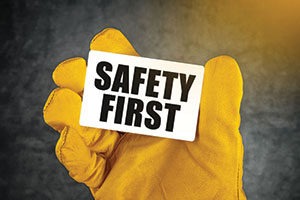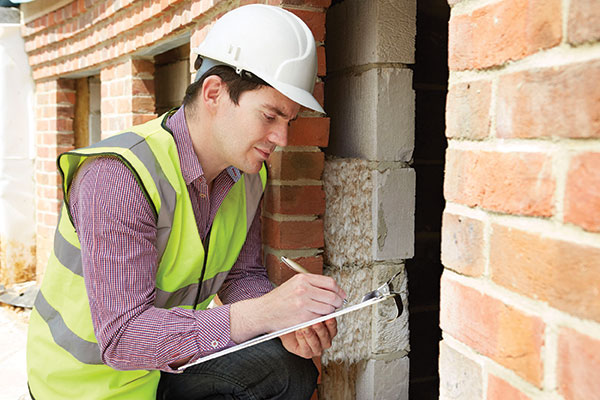Safety on the Jobsite
By Zach Everett
There are many reasons why workplace safety inspections are essential. Safety inspections prevent injuries, illnesses, and deaths on the job. Let’s discuss how inspections prevent injuries and also several other things accomplished by jobsite safety inspections.
Why Are Safety Inspections Necessary?
Inspecting a project for safety deficiencies, but more importantly hazards, helps establish what is called a hazard analysis. With that information, you’re able to make decisions on what is needed on the job, such as personal protective equipment, tools, equipment and training, to name a few.
Some of the questions you should ask are:
- Is the environment wet or muddy? Is it hot or cold?
- What equipment is needed, or what equipment might be creating hazards on the job?
- Are there noise hazards or vibration?
- Will work be done at night or during the day? Is there proper lighting?
- Is there proper ventilation?
- Are there guards on all the equipment and tools?
- Are there biological hazards or chemicals being worked with? What are those chemicals, and how do we prevent injury from them?
- Are there ergonomic hazards, such as lifting bags of mortar or heavy block or stone?
- Is there repetitive motion?
- Are the tools being used the right tools for the job? Are they hand tools or power tools?
- Are there any electrical hazards in the area?
Safety Tips
Safety in the Saw Area |
| The area around a masonry saw can become very dangerous if not kept up properly. The first item to have is a small dumpster placed next to the saw for material waste. Tripping hazards are the last thing you want around a fast-spinning blade. Masons like to have their material close to the saw, with an extra pallet to place the newly cut items. These need to be placed close, but not so close as to interfere with the process of cutting or to catch on clothing.
Another item of great value in the saw area is a rubber mat with holes in it — the ones used around garage workbenches. Usually they are at least 1 inch thick. These work well both inside and outside to keep the saw person out of mucky slurry, and to keep one’s feet dry. The mess of the slurry can become a slip hazard very quickly, especially indoors. Also, the mat prevents the fatigue on your feet that would otherwise be felt from standing on a concrete surface all day. A pail of water with a wash-down brush is usually placed next to the saw to help keep warning labels visible and to keep the tape measure readable on the table. Last is a plastic tote to keep all the PPE for the saw, so it does not become lost or damaged. The PPE includes aprons, rubber boots, safety glasses, a hard hat with a face shield (my company has been using the logger-style mesh mask instead of plastic), rubber gloves and ear protection. Depending on the water pump design of the saw, you may have an extra pump for backup. The saw should also be properly maintained to make sure all guards are on and functional. With these safety precautions in place, you’ll lower the risks of using a masonry saw. Paul M. Cantarella, Cantarella & Son, Inc. Pittsfield, Mass. |
By having an intimate understanding of the job and its processes, we are able to better identify the hazards associated with our individual tasks and then how to protect ourselves from those hazards so that we may go home healthy.
Other Benefits From Jobsite Safety Inspections
 Besides the most important reason of keeping our people safe from injuries, illnesses and death, there are other reasons to perform jobsite safety inspections. One is so that we can listen to the concerns of our workforce. When we’re out in the field, we can see them in action and can talk to them and understand what they’re dealing with, which will better equip us to give them what they need to accomplish the job safely. We may be able to find underlying reasons why hazards present themselves or why employees are having behavioral problems with safety. For example, someone may be having a hard time at home; a marital conflict or problems with kids may be affecting his state of mind on the job. Inspecting the jobsite also gives us an opportunity to re-evaluate our safety program. Perhaps by the inspection, we will see lagging indicators and violations, which tell us that we need to step up our written program or safety program in general.
Besides the most important reason of keeping our people safe from injuries, illnesses and death, there are other reasons to perform jobsite safety inspections. One is so that we can listen to the concerns of our workforce. When we’re out in the field, we can see them in action and can talk to them and understand what they’re dealing with, which will better equip us to give them what they need to accomplish the job safely. We may be able to find underlying reasons why hazards present themselves or why employees are having behavioral problems with safety. For example, someone may be having a hard time at home; a marital conflict or problems with kids may be affecting his state of mind on the job. Inspecting the jobsite also gives us an opportunity to re-evaluate our safety program. Perhaps by the inspection, we will see lagging indicators and violations, which tell us that we need to step up our written program or safety program in general.
Safety On The Jobsite
Skilled, Knowledgeable and Safe |
| How LIUNA Training Turns Out Safe Laborers
For LIUNA Training and Education Fund (LIUNA Training) and its affiliated network of training centers, safety is a top priority. Safety is not only a cornerstone of journey-worker and apprenticeship training, but it is also integrated into LIUNA Training’s instructor certification and Train-the-Trainer programs. LIUNA Training infuses safety concepts into all its courses, which cover everything from general construction safety and OSHA safety training requirements to specialized safety information and skills that address a wide variety of job hazards. An experienced mason tender knows the potential hazards on a jobsite are many, whether it’s cutting brick or block, driving a forklift, or erecting and working on scaffolding. That is why LIUNA Training’s apprenticeship program offers a concentration in masonry. Journey-workers can take a variety of masonry-specific courses that cover safety skills. The first two hours of LIUNA Training’s 40-hour Mason Tender class are dedicated solely to safety and health. Trainees learn such essentials as how to use personal protective equipment and the damaging effects of silicosis and cement contact dermatitis. The Mason Tender course also weaves safety into each classroom lesson and hands-on activity. Trainees learn about the importance of pacing and developing a work schedule, material strength and stability, the use of temporary bracing, and the impact of weather. LIUNA Training also features information on reducing back injuries and utilizing respiratory protection. OSHA 10 and OSHA 30 courses help trainees learn how to recognize potential jobsite hazards and prevent injuries to themselves, their co-workers and the public. The quality of LIUNA Training’s safety and health program is also evident in the instructors themselves. LIUNA Training builds on each instructor’s experience by providing them with professional development and career-long education and training opportunities. The cornerstone of this process is the Instructor Certification Program, accredited by the American National Standards Institute (ANSI). Once certified, LIUNA instructors can enroll in the Masters of Instruction program, which is available in three tracks: Trainer-of-Trainers, Curriculum Design, and Vocational English for Speakers of Other Languages. Lastly, LIUNA Training offers instructor programs that focus on safety, supervision, and trade skills in construction and environmental remediation. LIUNA Training’s integrated, comprehensive approach to apprentice, journey-worker and instructor training is a frontline force for a safe, skilled and productive workforce. Mark Mancini is the communications/staff writer for the LIUNA Training and Education Fund. He can be reached at mmancini@liunatraining.org. |
A Few Concluding Points
Let’s address a few more issues concerning a safety inspection.
Who should do the report? A safety person would be at the top of the list to carry out this inspection, but he/she is not the only one who can do it. A corporate safety director, any safety manager who works under him, general superintendents, project managers, and basically anyone who is knowledgeable of safety and goes on the job should be responsible for performing a safety inspection while there. Whether that inspection translates into a written report or not is up to the owner of the company and the safety director.
Should it be a written report, or should a checklist be used? I am a fan of any written safety report. Even if a project manager or a general superintendent is performing the inspection, I believe it is well worth the time to generate at least a brief written report of the observations. Having a paper trail recording the observations and any corrections made is worth a great deal in a court room, for example.
How often should inspections be conducted? The frequency of inspections is contingent on what is being inspected. Scaffolding, for example, must be inspected before each shift and before employees can be released to work from the scaffold. Concerning a more general safety inspection of the job, the site superintendent should do a daily inspection, and an inspection whenever a new hazard is introduced into the employees’ tasks. Project managers, safety personnel and similar individuals are not given specific regulations by OSHA, but I believe they should do an inspection each time they go to a project site. This helps to comply with OSHA standards, such as re-evaluating the safety program; but most importantly, it can stop unsafe acts and conditions that could result in injuries or worse.
If there are violations or deficiencies, how should those things be corrected and followed up on? Any time a violation is observed, it needs to be stopped and corrected. Some employees may require disciplinary action, some may not. Each situation should be evaluated on its own merits. It may be a training issue or supervision issue.
All safety-related observations should be recorded, as well as the corrections made. There are many existing safety inspection checklists that can be utilized, or you could create your own or choose from several smartphone apps. The bottom line is that safety inspections are an essential part of a safety program. Most importantly, they save lives!
Zach Everett is corporate safety director for Brazos Masonry. He can be reached at zeverett@brazosmasonry.com.

